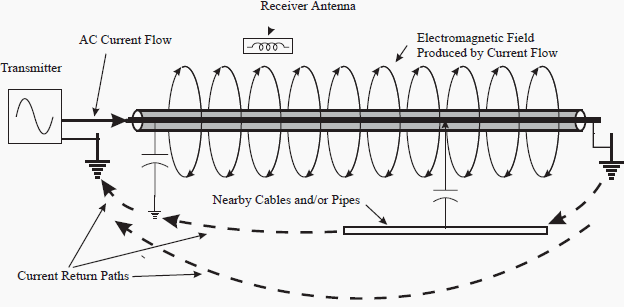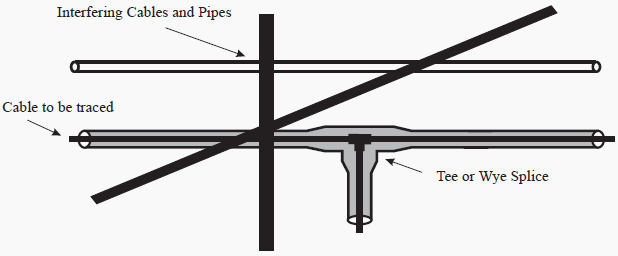Overview of underground cable faults
Before attempting to locate underground cable faults on direct buried primary cable, it is necessary to know where the cable is located and what route it takes. If the fault is on secondary cable, knowing the exact route is even more critical.

Since it is extremely difficult to find a cable fault without knowing where the cable is, it makes sense to master cable locating and tracing and to do a cable trace before beginning the fault locating process.
Success in locating or tracing the route of electrical cable and metal pipe depends upon knowledge, skill, and perhaps, most of all, experience. Although locating can be a complex job, it will very likely become even more complex as more and more underground plant is installed. It is just as important to understand how the equipment works as it is to be thoroughly familiar with the exact equipment being used.
- The transmitter — an ac generator which supplies the signal current on the underground cable or pipe to be traced.
- The receiver — detects the electromagnetic field produced by the transmitted ac current flow. See Figure 1 at the top.
Before starting, it will be helpful to obtain the following information:
- What type of cable is it?
- Is the cable the same type all the way along its length?
- Is the target cable the only cable in the trench?
- Are there any taps?
- Is the cable run single phase or multiphase?
- Is the cable shielded or unshielded?
- Is the cable direct buried or in conduit?
- Are there metal pipes or other underground structures under, over or near the target cable?
- Is the target cable connected to other cables or pipes through grounded neutrals?
This information will help to select the most appropriate locator and to prepare to locate the cable successfully. See Figure 2 below.

Many transmitters are equipped with some means of indicating the resistance of the circuit that it is trying to pump current through and can indicate a measurement of the current actually being transmitted.
Output current can be checked in several ways as follows:
1. – By measuring the resistance of the circuit with an ohmmeter
When the resistance is less than approximately 80,000 Ω, there will typically be enough current flowing in the cable to allow a good job of tracing.
This is no guarantee that the transmitted current is passing through the target cable. The measured resistance may be affected by other circuits or pipes electrically connected to the target cable acting as parallel resistances. See Figure 3 below.

2. – By observing the actual signal strength being transmitted by the transmitter
Many transmitters provide a measurement or some indication of output current. A loading indicator on the MEGGER’s Portable Locator Model L1070 blinks to indicate the approximate circuit resistance. A rate of four blinks per second indicates a low resistance, almost a short circuit providing a very traceable signal.
A rate of one blink every three seconds shows a high resistance and a weaker signal.
3. – By observing the signal power detected by the receiver
Signal level indicator numbers are displayed digitally on most receivers and older models may display signal power with analog meters. The L1070 has both an analog style signal strength bargraph plus a digital numeric readout. Tracing experience gives the operator the ability to judge whether or not the numbers are high enough.
This is the most practical way to check signal current flow.
Remember, the more current flow through the conductor the stronger the electromagnetic field being detected by the receiver and the further from the conductor being traced the less field is being detected.
Resource: Fault finding solutions by MEGGER











Who can I call In Gardnerville/Minden/Carson City NV to find a problem?
i am interested in the training as i intend to work with the equipment in a swamp area.please send to me the necessary requirements and fees for the training.
I always likes to read information from this site & very thankful for info
Amazing !!!
I always enjoy reading your topics, you keep it short and so rich of information, thank you